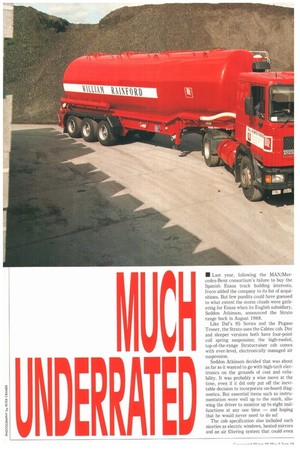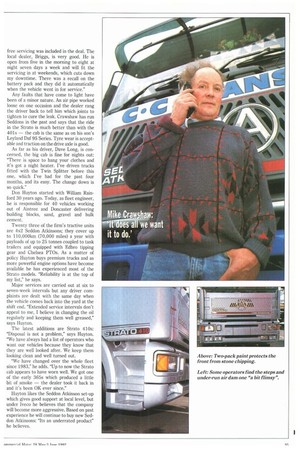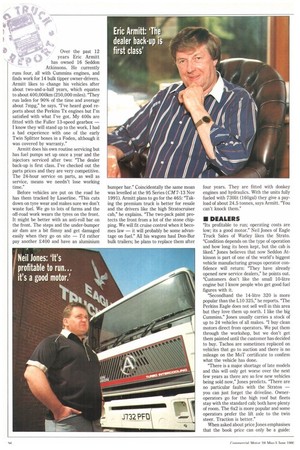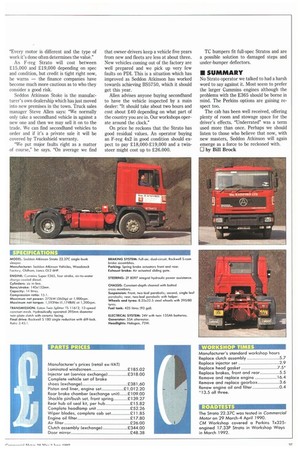• Last year, following the MAN/Mercedes-Benz consortium's failure to buy
Page 34

Page 36

Page 37

Page 38

Page 39

If you've noticed an error in this article please click here to report it so we can fix it.
the Spanish Enasa truck building interests, Iveco added the company to its list of acquisitions. But few pundits could have guessed to what extent the storm clouds were gathering for Enasa when its English subsidiary, Seddon Atkinson, announced the Strato range back in August 1988.
Like Daf's 95 Series and the Pegaso Troner, the Strato uses the Cabtec cab. Day and sleeper versions both have four-point coil spring suspension; the high-roofed, top-of-the-range Stratocruiser cab comes with ever-level, electronically managed air suspension.
Seddon Atkinson decided that was about as far as it wanted to go with high-tech electronics on the grounds of cost and reliability. It was probably a wise move at the time, even if it did only put off the inevitable decision to incorporate on-board diagnostics. But essential items such as instrumentation were well up to the mark, allowing the driver to monitor up to eight malfunctions at any one time — and hoping that he would never need to do so!
The cab specification also included such niceties as electric windows, heated mirrors and an air filtering system that could even remove pollen. All of the cab's steel panels were galvanised and, • as further protection against stone chipping, the paint finish was almost 45% thicker than the industry average.
The first Strato tractors were based around the classic Cummins/Eaton/Rockwell driveline. Initially there were two basic engine options: the air-to-air charge-cooled LTAA-10 offering 224-242kW (300325hp), and the 14-litre unit, rated at 239, 261 or 298kW (320, 350 or 400hp), All Stratos come with exhaust brake, heated fuel filter, viscous fan, ceramic-faced clutch and an Eaton Twin Splitter constantmesh gearbox as standard. The Cablecraft gear linkage can handle enough misalignment to accommodate cab movement and, more importantly, does away with the need for holes in the floor pan.
The rear axle has a design weight of 11 tonnes; the Seddon Atkinson front axle is rated at 7.1 tonnes. Longer steel leaf springs soften the ride, but anti-roll bars are only fitted as an option. Many of the chassis components are unchanged from the earlier 4-11 models and the chassis side rail is the same depth, but the frame is narrower. All air reservoirs are grouped together and are fitted with an air dryer.
‘41 tog) 0
• EVOLUTION
With the introduction of a 6x2 Strata tractive unit in April 1989 Seddon Atkinson opted for the air-to-water charge-cooled Cummins E365 in preference to the wellrespected E350.
In June the charge-cooled Perkins Eagle 325Tx 12-litre power unit became available on the 4x2 but it was not offered on the 6x2 until December. Also in June the E365 was introduced to the 4x2; it superseded the E350 the following month.
This engine has the same cylinder head design as the E465, the most powerful engine option ever offered by Seddon Atkinson, with deep valve pockets and the higher 15:1 compression ratio. Both engines use eight-hole, fine nozzle injectors, designed to give a more complete combustion, but only the 365 seems to have run into fuelling problems.
This cropped up on ERF and Foden chassis as well.
The E365 was replaced in January this year by the E410; at the same time 283 and 298kW (380 and 400hp) versions of the Perkins Eagle were made available.
Before the end of 1992 Cummins will have revised its 10 and 14-litre engines and no doubt Seddon Atkinson will take advantage of the changes. These will include a 261kW (350hp) L10 with full electronics, and 246kW (330hp) versions of its 10 and 14-litre blocks. The E365 will become the E380.
• OPERATORS
We met up with Mike Crawshaw on the job — transporting steel on an extending semitrailer out of Scunthorpe, where he set up a haulage business with his wife and son 10 years ago.
His fleet of five vehicles includes a J-reg Strato 365 6x2 twin steer tractor, which replaced a Daf 3300 with a lift axle. "I really wanted an 80-tonne plate but settled for 65 tonnes," he says. "We bought it last November and it does all we want it to do. The axle weights are ideal for low loader work but we use it mainly for long loads of steel and concrete beams of up to 24m. We wanted the economy of the Cummins engine — about 75% of our jobs are under 38 tonnes and we cover 130,000km (80,000 miles) a year. We are getting over 8mpg." Crawshaw likes to change his vehicles after about three years hut, like so many operators, he is hanging on to them until there is more work about.
"I do as much servicing as I can in house and only pay for the big jobs outside," he says. 13ut when I bought the Strato a year's free servicing was included in the deal. The local dealer, Briggs, is very good. He is open from five in the morning to eight at night seven days a week and will fit the servicing in at weekends, which cuts down my downtime. There was a recall on the battery pack and they did it automatically when the vehicle went in for service."
Any faults that have come to light have been of a minor nature. An air pipe worked loose on one occasion and the dealer rang the driver back to tell him which joints to tighten to cure the leak. Crawshaw has run Seddons in the past and says that the ride in the Strato is much better than with the 401s — the cab is the same as on his son's Leyland Daf 95 Series. Tyre wear is acceptable and traction on the drive axle is good.
As far as his driver, Dave Long, is concerned, the big cab is fine for nights out: "There is space to hang your clothes and it's got a night heater. I've driven trucks fitted with the Twin Splitter before this one, which I've had for the past four months, and its easy. The change down is so quick."
Don Huyton started with William Rainford 30 years ago. Today, as fleet engineer, he is responsible for 40 vehicles working out of Aintree and Doncaster delivering building blocks, sand, gravel and bulk cement.
Twenty three of the firm's tractive units are 4x2 Seddon Atkinsons; they cover up to 110,0001fin (70,000 miles) a year with payloads of up to 25 tonnes coupled to tank trailers and equipped with Edbro tipping gear and Chelsea PT0s. As a matter of policy Huyton buys premium trucks and as more powerful engine options have become available he has experienced most of the Strato models. "Reliability is at the top of my list," he says.
Major services are carried out at six to seven-week intervals but any driver complaints are dealt with the same day when the vehicle comes back into the yard at the shift end. "Extended service intervals don't appeal to me, I believe in changing the oil regularly and keeping them well greased," says Huyton.
The latest additions are Strato 410s: "Disposal is not a problem," says Huyton. "We have always had a list of operators who want our vehicles because they know that they are well looked after. We keep them looking clean and well turned out.
"We have changed over the whole fleet since 1983," he adds. "Up to now the Strato cab appears to have worn well. We got one of the early 365s which produced a little bit of smoke — the dealer took it back in and it's been OK ever since."
Huyton likes the Seddon Atkinson set-up which gives good support at local level, but under Iveco he believes that the company will become more aggressive. Based on past experience he will continue to buy new Seddon Atkinsons: "Its an underrated product" he believes. Over the past 12 years Eric Armitt has owned 16 Seddon Atkinsons, He currently runs four, all with Cummins engines, and finds work for 14 bulk tipper owner-drivers. Armitt likes to change his vehicles after about two-and-a-half years, which equates to about 400,0001cm (250,000 miles). "They run laden for 90% of the time and average about 7mpg," he says. 'I've heard good reports about the Perkins Tx engines but I'm satisfied with what I've got. My 400s are fitted with the Fuller 13-speed gearbox — I know they will stand up to the work. I had a bad experience with one of the early Twin Splitter boxes in a Foden, although it was covered by warranty."
Armitt does his own routine servicing but has fuel pumps set up once a year and the injectors serviced after two: "The dealer back-up is first class. I've checked out the parts prices and they are very competitive. The 24-hour service on parts, as well as service, means we needn't lose working time."
Before vehicles are put on the road he has them tracked by Laserline. "This cuts down on tyre wear and makes sure we don't waste fuel. We go to lots of farms and the off-road work wears the tyres on the front. It might be better with an anti-roll bar on the front. The steps and the under-bumper air dam are a bit flimsy and get damaged easily when they go on site — I'd rather pay another £400 and have an aluminium bumper bar." Coincidentally the same moan was levelled at the 95 Series (CM 7-13Nov 1991). Armitt plans to go for the 465: "Taking the premium truck is better for resale and the drivers like the high Stratocruiser cab," he explains, "The two-pack paint protects the front from a lot of the stone chipping. We will fit cruise control when it becomes law — it will probably be some advantage on fuel." All his wagons haul Don-Bur bulk trailers; he plans to replace them after four years. They are fitted with donkey engines and hydraulics. With the units fully fueled with 7301it (160gal) they give a payload of about 24.5 tonnes, says Armitt. 'You can't knock them."
• DEALERS
"Its profitable to run; operating costs are low; its a good motor," Neil Jones of Eagle Truck Sales of Warley likes the Strato. "Condition depends on the type of operation and how long its been kept, but the cab is liked." Jones believes that now Seddon Atkinson is part of one of the world's biggest vehicle manufacturing groups operator confidence will return: "They have already opened new service dealers," he points out. "Customers don't like the small 10-litre engine but I know people who get good fuel figures with it.
"Secondhand the 14-litre 320 is more popular than the LIO 325," he reports. "The Perkins Eagle does not sell well in this area but they love them up north. I like the big Cummins." Jones usually carries a stock of up to 24 vehicles of all makes. "I buy clean motors direct from operators. We put them through the workshop, but we don't get them painted until the customer has decided to buy. Tachas are sometimes replaced on vehicles that go to auction and there is no mileage on the MoT certificate to confirm what the vehicle has done.
"There is a major shortage of late models and this will only get worse over the next few years as there are so few new vehicles being sold now," Jones predicts. "There are no particular faults with the Stratos — you can just forget the driveline. Owneroperators go for the high roof but fleets stay with the standard cab; both have plenty of room. The 6x2 is more popular and some operators prefer the lift axle to the twin steer. Traction is better," When asked about price Jones emphasises that the book price can only be a guide: "Every motor is different and the type of work it's done often determines the value."
An F-reg Strato will cost between £15,000 and £19,000 depending on spec and condition, but credit is tight right now, he warns — the finance companies have become much more cautious as to who they consider a good risk.
Seddon Atkinson Stoke is the manufacturer's own dealership which has just moved into new premises in the town. Truck sales manager Steve Allen says: "We normally only take a secondhand vehicle in against a new one and then we may sell it on to the trade. We can find secondhand vehicles to order and if it's a private sale it will be covered by Truckshield warranty.
"We put major faults right as a matter of course," he says. "On average we find
that owner-drivers keep a vehicle five years from new and fleets are less at about three. New vehicles coming out of the factory are well prepared and we pick up very few faults on PD!. This is a situation which has improved as Seddon Atkinson has worked towards achieving BS5750, which it should get this year.
Allen advises anyone buying secondhand to have the vehicle inspected by a main dealer: "It should take about two hours and cost about £40 depending on what part of the country you are in. Our workshops operate around the clock," On price he reckons that the Strata has good residual values. An operator buying an F-reg 4x2 in good condition should expect to pay £18,000-£19,000 and a twinsteer might cost up to £26.000. TC bumpers fit full-spec Stratos and are a possible solution to damaged steps and under-bumper deflectors.
• SUMMARY
No Strata operator we talked to had a harsh word to say against it. Most seem to prefer the larger Cummins engines although the problems with the E365 should be borne in mind. The Perkins options are gaining respect too.
The cab has been well received, offering plenty of room and stowage space for the driver's effects. "Underrated" was a term used more than once. Perhaps we should listen to those who believe that now, with new masters, Seddon Atkinson will again emerge as a force to be reckoned with.
0 by Bill Brock




















































































